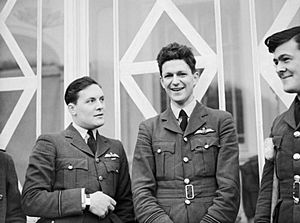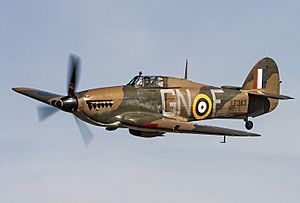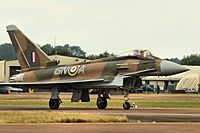James Brindley Nicolson facts for kids
Quick facts for kids
James Brindley Nicolson
|
|
|---|---|

Flight Lieutenant Nicolson (centre) while recuperating from wounds after his VC action, November 1940
|
|
| Born | 29 April 1917 Hampstead, London |
| Died | 2 May 1945 (aged 28) Bay of Bengal |
| Allegiance | United Kingdom |
| Service/ |
Royal Air Force |
| Years of service | 1936–1945 |
| Rank | Wing Commander |
| Service number | 39329 |
| Unit | No. 72 Squadron No. 249 Squadron |
| Commands held | No. 27 Squadron |
| Battles/wars | Second World War
|
| Awards | Victoria Cross Distinguished Flying Cross |
James Brindley Eric Nicolson, VC, DFC (29 April 1917 – 2 May 1945) was a fighter pilot and wing commander in the Royal Air Force during the Second World War. He was a recipient of the Victoria Cross, the highest award for gallantry in the face of the enemy that can be awarded to British and Commonwealth forces, for his actions in August 1940 during the Battle of Britain.
Early life
James Brindley Eric Nicolson was born in Hampstead, London, on 29 April 1917, and was educated at Yardley Court and Tonbridge School. In 1935 Nicolson began work as an engineer at Ricardo Engines. In 1936 he joined the Royal Air Force, with the service number 39329. After his training he joined No. 72 Squadron in 1937 and later moved to No. 249 Squadron in 1940.
Second World War

Nicolson was 23 years old and a flight lieutenant in No. 249 Squadron during the Second World War when he was awarded the Victoria Cross. On 16 August 1940 having taken off from RAF Boscombe Down near Salisbury, Nicolson's Hawker Hurricane was almost certainly fired on by the Messerschmitt Bf 109 of Heinz Bretnutz of II./JG 53, who returned to base with claims for two Hurricanes following this action. Nicolson's engine was damaged and the petrol tank set alight. As he struggled to leave the blazing machine he saw another Messerschmitt, and managing to get back into the bucket seat, pressed the firing button and continued firing until the enemy plane dived away to destruction. Not until then did he bail out, and he was able to open his parachute in time to land safely in a field. On his descent, he was fired on by members of the Home Guard, who ignored his cry of being a RAF pilot.
Commemoration

In 2015, the RAF repainted a modern Eurofighter Typhoon jet, ZK349, in Second World War colours, and applied Nicolson's squadron number, GN-A, to commemorate the 75th anniversary of the Battle of Britain.

